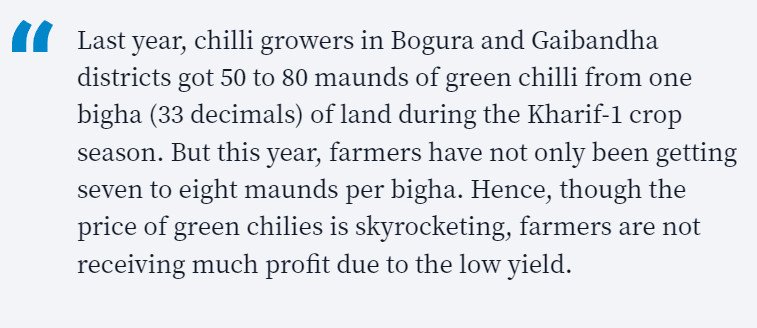July 28, 2023
DHAKA – What weighs heaviest on the minds of buyers at kitchen markets? It can only be the fact that vegetables which could be bought at Tk 25-35 per kg last year have to now be bought at three times the price. The latest example of this has been the price of green chillies.
Every year, there is a shortage of green chilies during the monsoon and their prices increase abnormally for a short period. But, until this year, the price of green chillies has never gone up as high as Tk 700 per kg.
While media reports have shown traders’ syndicates being blamed for the price hike, this is not entirely true. There is another crisis in the background. Upon visiting a green chilli field in person and speaking to the farmers, one can uncover a different story.
According to farmers, the yield this season has not been good. The scarcity of rain before monsoon and the lasting heat wave caused the plants to shed their flowers and fruits.
Climate change has caused the occurrence of the El Nino phenomenon, which is a climate pattern associated with the warming of the ocean’s surface in the central and eastern tropical Pacific Ocean. Though the full effects of El Nino are still unknown, it is usually associated with floods, droughts, cyclones, and other natural disasters that affect agriculture in developing countries.
Last year, chilli growers in Bogura and Gaibandha districts got 50 to 80 maunds of green chilli from one bigha (33 decimals) of land during the Kharif-1 crop season. But this year, farmers have not only been getting seven to eight maunds per bigha. Hence, though the price of green chilies is skyrocketing, farmers are not receiving much profit due to the low yield.
Furthermore, farmers say that the leaves of the plants have curled up due to the prolonged heat waves. The yield is also low due to the flowers not being pollinated properly. In fact, the yield of almost all types of summer vegetables has decreased this crop season.
According to the Department of Agriculture Extension (DAE) in Bogura, 20-25 types of vegetables are being produced in Kharif-1. Last year, farmers got an average of 21.25 tonnes of vegetables per hectare, but this year they are getting 20.25 tonnes per hectare. Simply put, the production of vegetables has decreased by a tonne per hectare this summer.
On the other hand, last year in Bogura vegetables were cultivated on 6,500 hectares of land. But due to the lack of rainfall this year, only 4,250 hectares of land has seen cultivation.

Given this situation, at the end of June, the government temporarily allowed traders to import chillies from India. However, the price of green chillies has been increasing in India, too. One report stated that, in the first week of this month, green chillies were sold in Delhi for the staggering retail price of Rs 400 per kg. Agricultural experts in India have cited adverse weather conditions as one of the main reasons behind the low production of green chillies.
Usually, the average temperature in early June is between 32 and 34 degrees Celsius in Bangladesh. But this June saw average temperatures between 38 and 41 degrees Celsius, breaking the record of the last 50 years.
Shailendra Nath Mazumder, principal scientific officer at the Spice Research Center (SPC) in Bogura, says that chilli plants cannot withstand high temperatures. Generally, temperatures above 33 to 35 degrees Celsius disrupt the pollination of pepper flowers. As the temperature has crossed 35 degrees on many days this season, the yield of green chillies has decreased significantly.
Of course, it is beyond a farmer’s capabilities to know how to surpass this situation. And when consulted, agriculturists have said that we need to develop drought- and temperature-tolerant varieties of plants to solve this issue. Farmers could also set up a pollination house to grow chillies under controlled temperatures. Unfortunately, our poor farmers generally lack the resources and training to implement such technologies.
What can be the solution? Sure, if we all grow three or four chilli plants in our yards, rooftops, or balconies, we would not have to buy as many green chillies from the kitchen market. But what would be the use of this if the plants cannot bear fruit due to regular heat waves?
The bottom line is that climate change is making warmer regions of the world even warmer. As a result, farmers and agriculture are suffering. The government of Bangladesh seems not to be worried at all about this, even though this might cause us huge sufferings. El Nino may disrupt food production around the world for years to come, which will put the food security of developing countries at greater risk.
During its lengthy tenure, as much as the government has emphasised infrastructural development, it has also neglected agricultural development. But during any crisis (such as a war in Europe or the Covid pandemic), it is our agriculture that can keep us alive and well. Modernising Bangladesh’s agriculture sector would require extensive research. Since we have less land to cultivate and a bigger population to keep fed, huge efforts are needed for growing high-yield, temperature-tolerant crop varieties. The government must plan better for the agriculture sector, beyond subsidies. If we are not able to adequately address the dire effects of climate change on our agriculture, our future food security will be all the more vulnerable.


